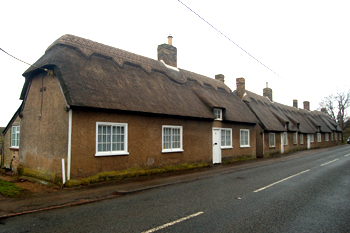
1 to 4 The Bungalows February 2010
This row of thatched cottages was listed by the former Department of Environment in August 1983 as Grade II, of special interest. The department dated the buildings to the 18th century. They are constructed of roughcast over a timber frame and have thatched roofs over a single storey with attics. 20th century single storey additions lie to the rear.
The Rating and Valuation Act 1925 specified that every building and piece of land in the country was to be assessed to determine its rateable value. Most of Bedfordshire was valued in 1927 and the valuer visiting The Bungalows [DV1/C257/12-15] found them all owned by Lord of the Manor Charles Edmund Argentine Allington J. P. of The New Manor House.
Number 1 was occupied by E. Church who paid three shillings per week in rent. Accommodation comprised a living room and kitchen, three bedrooms and a washhouse. It was not attached to the rest of the terrace though built in the same fashion and adjoining the north end of the terrace. The valuer noted: Very nice” and “No upstairs, stairs taken away”. He concluded “Quite nice looking cottage”.
Number 2 was first of the terrace of three. It was occupied by Henry Gray, a tobacconist who also kept the Post Office. This property remained the village post office into the 1970s as it is so marked on Ordnance Survey maps. Rent was £1/10/- per annum and accommodation comprised a living room, kitchen, three bedrooms and a washhouse. A barn and a small unheated glasshouse stood outside. The valuer commented: “All very nice, roof not used, look very neat”. Kelly’s Directory for Bedfordshire lists Henry Gray as postmaster in its editions of 1914, 1920, 1924, 1928, 1931 and 1936. In the last edition for Bedfordshire, that of 1940, the postmistress is Miss Evelyn Annie Gray. Directories also list Henry Gray simply as a provision dealer from 1898 to 1910.
Number 3 was unoccupied and comprised a living room, kitchen, three bedrooms and a washhouse. Number 4 was occupied by F. Tysoe who paid no rent and occupied a living room, kitchen, two bedrooms and a washhouse.
In 1885 and 1894 the provision dealer in the village was Mrs. Mary Jarvis though, as no address is given, it is not possible to say whether she was at the same address as Henry Gray’s. Phillip Jarvis was listed as shopkeeper in 1864 and 1869, Fanny Jarvis as grocer and tea dealer in 1861 and Matthew Tatman as dealer in tobacco in 1847.